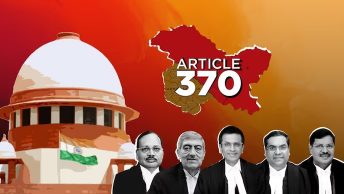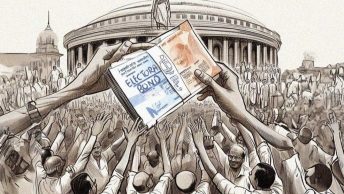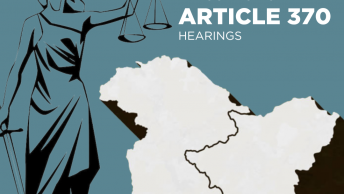HLS Library Book Talk | Supreme Court of India: The Beginnings
I’m coming at this obliquely, firstly, because I’m a scholar of the colonial period of India’s legal history. And so where I end, George Gadbois’ book begins (although we have an overlap for a couple of years in the late colonial period). Secondly, there are a number of courts in the story. I’ve worked on and with the archives of a couple of them, but they’re not the big courts that the Gadbois book is focused on, namely, the Federal Court and the Indian Supreme Court. I’ve worked on the Bombay High Court and with the Judicial committee of the Privy Council. So, I’m coming at this from the side, like I said, in a couple of ways.
The first question I’d like to ask is: what does George Gadbois’s book and dissertation have to offer us 53 years after it was completed? There’s an unfortunate tendency with a lot of scholars to stop reading scholarship that is more than about 30 years old. And there’s no real reason for it, except volume, I guess. But that’s not really a good reason. Occasionally, I do dip back into work in Indian legal studies from the 1960s and 70s, and I’m thinking of work by people like Marc Galanter, Upendra Baxi, Rajeev Dhavan, Granville Austin, and George Gadbois. And when I do that, I am often reminded of the fact that we should not reinvent the wheel. We should keep reading some of the older classics in our field. I learned a couple of things from reading this book. It answered two questions that I’ve had for a long time. One was: how it is that Indian Supreme Court judges must retire at the age of 65? This rule has all kinds of consequences, including a very high turnover in judges. So how did the rule come to be? This book answers that question.
Another question I had for a long time was: where does this attitude come from in India that criminal appeals should be kept largely out of the upper courts? Again, George Gadbois’ book addresses the history of that discussion. So I got a lot out of reading this book. I think when we look at very new scholarship that’s coming out, it will be wonderful to read George Gadbois’s book alongside work by scholars like Rohit De who has written about the Federal Court and has got a very exciting book coming out on the Indian Supreme Court, and on the new book by Arun Thiruvengadam on the Indian Constitution.
A second thing that Gadbois’s book offers has to do with a tradition of scholarship coming of the USA and particularly, I think, coming out of US legal academia. There is a long history of comparative studies looking at the Indian and US law and courts by scholars based in the US. And there’s been a tendency sometimes to end up asking the question: how is it that India ended up lacking feature X, which we have in the US? When I started reading the book, I wondered if this was going to be an issue. I wondered if this was going to be the approach. But I was very happy to see that it is not. George Gadbois looks at Indian courts and Indian law on their own terms.
There is a comparative US-India thread running through the book. But it is embedded in the original primary sources that he’s using. Gadbois has a big discussion about why there is no due process clause in the Indian Constitution. Now you could think: well, why would there be? Why should we assume a kind of universal American baseline? But the fact is that there was initially a due process clause in an early draft of the Indian Constitution. And then it was removed and replaced with something else. So Gadbois is addressing debates of the era, comparisons made of the era, between India and the US, rather than imposing the American comparison himself from the outside. I was very happy to see this approach being taken.
I will also say that the conclusion of the book is absolutely superb. It is probably one of the best conclusions I have ever read in a book. Writing a good conclusion is a really hard thing, because you want to summarise. You have to summarise. But you also need to do something a little bit more. There needs to be some interesting twist or extension, or some added question. It can’t be too new because then it should really be a separate article or even a book itself. If you’re looking for a great model for a book conclusion, I highly recommend that you read this. Gadbois asks: what are the 10 most important moments if we move through the whole period that this book covers? And so, it’s a summary, but it’s also framed in a slightly different way from the rest of the book. And I thought it was highly productive and a great model.
Finally, I’ll just say that George Gadbois was writing this book as scholarship—as what we historians would call a secondary source. However, his book has now become a kind of primary source because it reflects upon the Indian Supreme Court in the 1960s, when he was writing. And so, a very big thank you to Vikram Raghavan and to Vasujith Ram for making this book happen. I know it was a big project. And it took a lot of time and energy, but it was worth it. Thank you for your wonderful introduction in the book. Thanks are due to George Gadbois’s family also for your help and cooperation.
There is one thing that I noticed here when asking myself the question: how have dissertations changed between 1965 and today? If this dissertation were written today, there would be more of an emphasis on archival research– research using unpublished sources–because the sources that are used here are all published. I think this would be true if you were a historian doing this work, or even a political scientist doing qualitative historical work or a historical sociologist. Today, I think there would be more of a focus on archival research as far as methodology is concerned.
Let me shift gear now and think a bit about how to situate this work historically. Because of my own focus on the colonial period, I’m going to situate it across the colonial and the post-colonial period of Indian history. So first, a little bit about courts, new courts, and founding institutional moments. The two courts that are at the forefront of this book, that get the spotlight, are the Federal Court created in 1937 and ending its life in 1950, and the Indian Supreme Court that began its life in 1950. But there are two other courts or court systems that are part of the portrait, but a little bit more in the backdrop. The first is the Judicial Committee of the Privy Council, which was the final court of appeal for the British empire. I will say on this, I’ve done work on the Privy Council and with their archive. It’s still a functioning court today on the Downing Street. And I will say, I was a little but surprised by the book’s rather positive take on that court, or rather, its account of very positive associations with the Privy Council. In my own research, I found a lot of criticism of the Privy Council in the late colonial period. And the criticism was essentially that these judges were dilettantes. This was a court that decided appeals coming from all across the British Empire. So these judges were dabbling in all of the different religious or personal law systems from South Asia and elsewhere. They were also applying not just common law traditions, but Roman Law traditions coming from places like South Africa and Quebec. And so, there was criticism not only from India, but from the other parts of the empire, too, particularly noting the fact that these judges had not been trained in many of the legal traditions they were applying. And yet, here they were handing out judgments in these areas. So, I guess I do differ a bit with George Gadbois in that one respect.
The final court that is part of the picture here is a whole system–that of the High Courts of India. Those were created in 1861. And I think that our field of Indian legal history needs more work done on that founding moment. I have a doctoral student named Cynthia Farid who is in part working on this, and I think there’s space for other scholars as well. It was an incredibly important new set of courts. And it signalled a real change in legal culture, in the legal profession specifically, because the rule change that accompanied these new courts allowed the legal profession in British India to become Indianized over the next few decades. This transformation would have huge consequences not just for the legal system, but for Indian political history as well, because many of those London-trained barristers from India ended up leading the independence or nationalist movement. So, I think we need to know more about the High Courts, from 1861 onwards.
The big theme that I wanted to think about historically today is the colonial continuities question. We hear about this in the news regularly now because of the debate over LGBTQ rights in India. And any day now, there’s going to be a new Supreme Court decision in this area. And it’s going to be very important. But one critique that we see of the Indian Penal Code Section 377, which is the unnatural offences (and anti-sodomy) provision – one critique that you see regularly is that it is a colonial-era law. And I’ve always found this critique a little-bit odd, because as George Gadbois notes in his book, large swathes of Indian law are colonial-era law. Both legislation and case law, plus a lot about how the legal profession runs. are essentially the same as they were, I would argue, in the colonial period. So, I’ve always found that a curious line of attack. What changed across independence? Well, obviously, the Constitution and the Indian Supreme Court. What did not change? Lots about legal culture and the legal profession. I want to focus on two things.
First of all, I’ll just say that a lot of employment priorities remained the same, I think, across independence. One of my favourite parts of the book is Chapter 3, which is all about the mechanics and inner workings of the judiciary. So, judicial appointments, judicial pensions, these things are incredibly important. They occupy a huge amount of people’s mental energy, I think, and they explain a lot about the patterns that you observe. They’re often quite hard to get at if you’re not inside the system yourself. And there are often very dry and boring to write about. But this chapter is actually extremely interesting. When I’m working in the colonial archives I’m often struck by how it seems like 50% of the archive is about pensions, appointments, promotions and leave. And I’ve often thought about doing a project on employment law in the empire because it is so important. So, this chapter, I thought, was really marvelous. And that set of priorities has continued across the colonial/post-colonial divide.
The thing I really want to talk about, though, is the rule of law. I want to situate the role of the rule of law in colonial and then post-colonial Indian history. What the Gadbois book offers us is a portrait of the continual struggles between the courts upholding rule-of-law values and constitutionalism, on the one hand, and government attempting to rule with unfettered power, on the other. I would argue that this was a story of continuity more that change as we move from the colonial to the post-colonial period. Now, the aims of the two different governments, of course, changed radically. The colonial government was all about the continuation of colonial rule. And colonial rule was all about the extraction of labor, profits and commodities from the colony for the benefit of the metropolitan elites and the metropole. The post-colonial state was all about Nehruvian socio-economic reform projects, at least up to the point that the book ends. So, I would argue that while the aims of the governments differ, the struggle over rule-of-law values between the courts and governments is there both before and after independence.
Now, there’s a problem in the field of Indian legal studies. There are two subfields which are speaking past each other. On the one hand, we have historians of colonial law who see the rule of law as inseparable from colonial rule, so they vilify it. They see the rule of law as the handmaiden or servant of colonialism. And then on the other hand, you have scholars of the post-colonial period who see the rule of law as exerting limits on state power. So, they take more of the classic lawyer’s approach, you could say. And on balance, they are positive about the rule of law as a set of values to aspire to.
The colonial historians, if asked to explain their position, see the rule of law as inescapably colonial because they point to, first of all, the fact that the rule of law was used as a pillar of the British civilising mission. The rule-of-law agenda was used as a justification for what the British were doing in India at all. Historians of the colonial period also point to all the racial injustices and inequalities carried out through the application of colonial law. Here, I think they make a mistake in the sense that they mistake rule by law– the practical application of law in India–with the rule of law as a set of aspirational values, as a set of ideas. I would argue–and I make this argument in a forthcoming article–that the rule of law, despite all of the contradictory practice in colonial India, retained immense rhetorical power as an ideal. Rule-of-law values were deployed in conflicts within the colonial state. We have the story of the Federal Court in the very end of the colonial rule upholding the rule of law in the face of wartime government legislation. We also have, before that, groups like the Punjab School of Public Administration, which essentially wanted to rule Indian without law. We have many accounts of European members of the Indian Civil Service in the colonial period who regarded lawyers, judges, and the courts as their natural enemies, as obstructions to colonial rule. Plus, the rule of law, as a set of ideals, was used by the early nationalists, by the early Congress movement, especially a group known as the constitutionalists–people like Dadabhai Naoroji, Pherozshah Mehta, and Dinsha Wacha–to point to the gap between British values and British practice. Un-British Rule is what they called it. So, my answer to the question, what was the relationship between the rule-of-law agenda and colonial rule? is that they were in a symbiotic relationship for much of British India’s history. They were intertwined in a relationship of mutual dependence that brought significant benefits to each. But they were different projects. Sometimes, they were at odds. And eventually, one (the rule of law) would help destroy the other (colonial rule). Why did the British then celebrate rule-of-law values so much during the colonial period? I would say because it was packaged and ready to ship in imperial metropolitan thought. But the British underestimated the concept’s autonomy and its potential to erode the foundations of British rule. If we look at it this way, the rule of law was not inescapably colonial. And thus, the rule of law and constitutionalism in independent India were not mere post-colonial hangovers or reflections of false consciousness. So, if we put this book, George Gadbois’s book, together with the longer context of modern Indian history, we get a long and distinctive history in India of rule-of-law values attempting at least to act as a counterforce to unfettered state power. And we see that both in the colonial and in the post-colonial periods.
Mitra Sharafi is a legal historian of modern South Asia. She teaches at the University of Wisconsin-Madison. The contents of the blog first appeared during HLS Library Book Talk on Supreme Court of India: The Beginnings (available here). It has been converted into a transcript by Bhavisha Sharma.







Your article helped me a lot, is there any more related content? Thanks! https://www.binance.info/en-IN/register?ref=UM6SMJM3